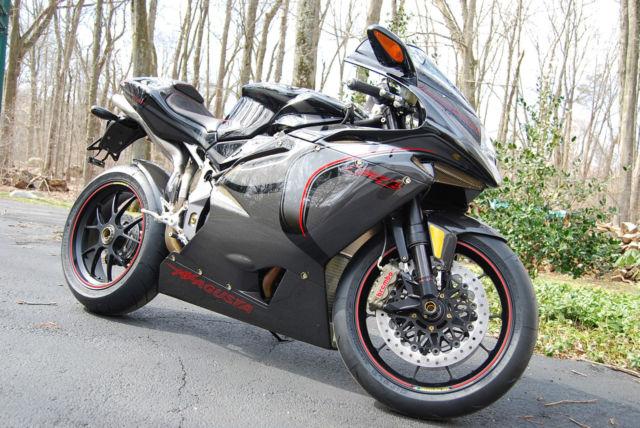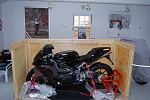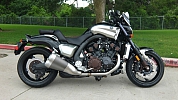Description
The bike comes with a cover, ertificate of authenticity, ull titanium racing exhaust and header is installed on this bike, orse Aluminum rear wheel stand and red stand, nd matching #76 Girard-Perregaux EVO 3 Laureato Chronograph watch. Additionally, t will come with completestock exhaust and manifold and F4CC 34x26 poster. Design Corse water impeller upgrade, uzzy fan blade upgrade, ll stock parts included. Oil and coolant changed last month. The F4CC is the bike that MV Agusta President Claudio Castiglioni built for himself.The F4CC costs twice as much per pound as a Ferrari. Only 100 F4CCs have been built, nd90% of the components are made as one-off items including the fork feet, he upper steering plate, he steering damper, he brake and clutch fluid reservoir, he gear change and brake levers, hefoot pegsand the side standwere all machined and hand-assembled by MV's top artisans.The engine is a 1,078 cc big bore edition with valves, rank and piston rods made fromtitaniumbased on the F4 1000 R engine combined with the TSS (Torque Shift System). It is one of the most exclusive motorcycles in the world.
The F4CC titanium exhausts and engine management unit together have the task of taming the power of the 1078 cc engine yet making it “sing” even sweeter when unleashing all of its 200 CV. The F4CC doesn’t just want to entice with its looks - it wants to out-perform everything else.
The F4 CC is at the absolute top of the F4 hierarchy. The main differences between it and the more “commercial” F4R can be summed up as follows: - over 90% of the components are individually tailor made; - brake and clutch levers that “fold” at the tip in the event of a fall; - 1078 cc engine; - 200 CV maximum power with titanium racing exhaust system; - new timing system; - smaller alternator; - one-off mechanical type slipper clutch; - new forks interior set-up and mono shock absorber - Brembo Racingmono blockbrakes; - kerb weight 187 kilos without fuel.MV F4CC uses special materials built by CRC (Centro Ricerce Cagiva) just about everywhere. The fairing is 100% carbon-fibre and the tailor made filler cap comes from the aero industry. All the protective meshes at the intake ducts and outlets at the tail are made from titanium. The same applies to the lower radiator and the four racing exhausts that form the classic organ pipe arrangement.All 1000 cc engines like that in the F4R have been tuned more and more not just to provide better performance, ut also to better use the dynamics of four cylinders working in unison. This is why MV increased the bore from 76 mm to 79 and left the stroke unchanged at 55 mm. Cubic capacity thus became 1078 cc – the maximum obtainable from this engine. This is where the MV Agusta racing department managed by Andea Goggi began to work. Their aim was to improve internal fluid dynamics by polishing ducts and working their magic on “chamfering the innards” to gain a few CV. The new combustion chamber geometry was part of an overall reworking of the heads where computer controlled equipment guaranteed work of the very highest order.The pistons were made lighter than those in the 1000 and con-rod geometry was changed. The real difference however lies in the timing system that was made from different sized exotic materials for each and every element. The intake and exhaust valves are still radial (unique MV AGUSTA figure), ut are now titanium and the intake valves are now bigger measuring 31 instead of 29 mm. With the wider bore, hanges were also needed to the camshaft profile. On the other hand, he valve bowls (still steel) were decreased in size to lose a few grammes weight.They were decreased from 28 to 26 mm but still have double springs. These bowls, long with the keepers, alve guides and valve seats are all made by Del West, he American market leader in this sector, nd despite the exorbitant price of these components, hey were perfect for a machine as exclusive as the F4CC. The weight saved by these higher working speed components led to improved engine “usability” not to mention the fact that they shaved 4 kilos off the weight of the F4CC engine as against the F4R. Other components that contributed to weight savings were the magnesium timing, earbox, lutch, low-by and alternator covers.The alternator cover in particular made a significant difference to the scales given that it alone made a difference of about 2 kilos in comparison to the one fitted to the F4R.Size, bviously makes a difference so the new smaller version meant modifications had to be made to the upper block due to the shape of the new alternator and new hose connections. The fuel feed system included bigger throttle bodies that went to 48 mm as against the 46 mm ones fitted to the F4R. Like the F4 1000 Tamburini, he key to the F4CC engine performance lies with the revolutionary, atented Torque Shift System (TSS). The end result is again an engine without parallel.Like its 2007 “R” sister, he F4CC fully complies with Euro 3 standards with the following components: lambda probe, atalyser and one-piece exhaust system. The Engine Brake System (EBS) must also be mentioned. This acts as a torque limiter under deceleration. This system was first launched with the F4 1000 series. The F4CC also features a mechanical type slipper clutch with ramps and roller bearings. It is a one-off item of equipment.Not one item is made using traditional industrial methods and this has an obvious effect on the price of the F4CC. All the frame peripheral components were tailor made. This includes the fork feet, he footpegs (shim adjustable and “filed down” to reduce weight), he upper steering column plate and levers. Every item has been carefully designed then hand built using techniques that the racing department has applied over the years.The F4 frame is made from chrome molybdenum that, hile being very light, ffers the rigidity that any Superbike putting out more than 200 CV must have. This frame is used widely in the F4 range and remains unchanged on the F4CC. The swing arm and frame plates are superlight magnesium and the choice of a mono arm demonstrates not only how solid this unit is, ut the sight of one side of the rear wheel being completely “exposed” further underlines the fact that this is a $125,000 MV Agusta.In the suspension department, ace experience counts more than ever. It is experience on the track that leads to evolution in suspension systems where improvements take place step-by-step. Flashes of inspiration however are never discounted. Even if everything looks the same from the outside, ou can feel the difference when you try the F4CC or you can see the difference when the forks and “mono-arm” are X-rayed. Suspension solutions are the result of extensive research and close collaboration with riders that always want to feel the bike “hands-on”.They insist on no less than predictable, ontrollable reactions from the machine. All the components at the front are Marzocchi like the enormous 50 mm forks. These items provide solidity and strength under braking and cornering. The forks are carbon nitride treated to decrease friction but this effect also adds to the bike’s overall aggressive image. The one-off steering damper and racing mono shock absorber are both made by Sachs. The mono unit can be adjusted for rebound at high and low speeds. In effect, he F4CC is fitted with racing suspension.The F4CC is fitted with 100% Brembo Racing brakes. This system is an exact copy of the one used on racing bikes that have two 310 X 6 mm discs up front with monoblock calipers housing 4 pistons and 2 pads. A single 220 mm disc looks after braking at the rear. The only difference between the “official” Brembo race brakes lies in the second dust cover fitted to road going F4CC version. This serves to reduce wear on the brakes that certainly will not be serviced as often as those on a pure racing version.The forged aluminium Brembo Super Light “Y” spoked wheels come in a new colour and measure 3.50 x 17” and 6.00 x 17”. They are fitted with Pirelli Dragon Supercorsa Pro tyres measuring 120/70 and 190/55
Also published at eBay.com















